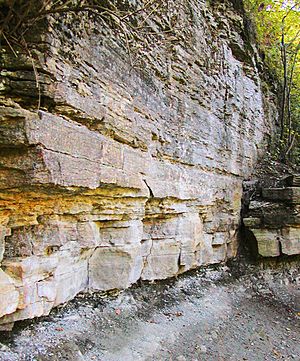Glenwood Shale facts for kids
Quick facts for kids Glenwood ShaleStratigraphic range: Ordovician |
|
|---|---|
| Type | Formation |
| Underlies | Platteville Formation |
| Overlies | St. Peter Sandstone |
| Location | |
| Country | United States |
| Extent | Minnesota |
| Paleozoic Stratigraphy of the Upper Midwest, USA Dates are approximate, and deposition occurred at slightly different times in different areas |
|---|
Ordovician
|
The Glenwood Shale is a special layer of rock found in the upper Midwestern United States. It formed a very long time ago, during the Ordovician period. This was about 450 million years ago!
This rock layer is made of shale, which is a type of rock formed from mud and clay. It's usually quite thin, sometimes less than 10 centimeters (about 4 inches) thick. Because it's so thin, people sometimes don't notice it when looking at rock layers.
What is the Glenwood Shale?
The Glenwood Shale sits like a sandwich filling between two other important rock layers. Below it is the St. Peter Sandstone, which is made of sand. Above it is the Platteville Limestone, which is made of a different type of rock.
These three layers together tell a story about the ancient seas. They show how the sea level changed during the Ordovician period. The Glenwood Shale formed when the sea was getting deeper. It was a time when fine mud settled on the seafloor.
Why is it Important?
Even though the Glenwood Shale is thin, it's very important to geologists (scientists who study rocks). It helps them understand the order of rock layers. It also helps them learn about how the environment changed millions of years ago.
This thin layer acts like a marker. It shows a clear change from the sandy environment of the St. Peter Sandstone to the limy environment of the Platteville Limestone. It helps scientists piece together the history of our planet.


